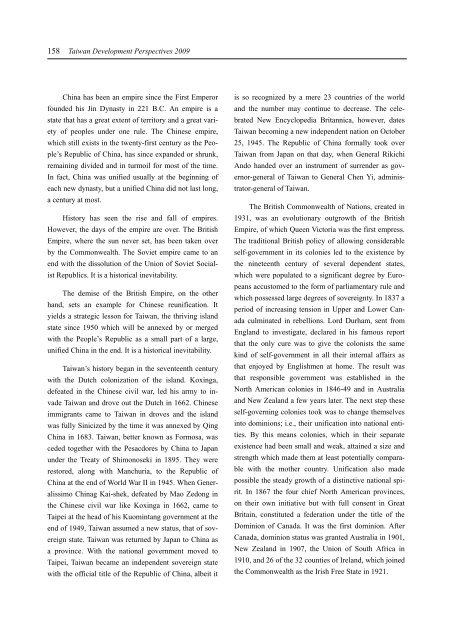PDF(2.7mb) - 國家政策研究基金會
PDF(2.7mb) - 國家政策研究基金會
PDF(2.7mb) - 國家政策研究基金會
You also want an ePaper? Increase the reach of your titles
YUMPU automatically turns print PDFs into web optimized ePapers that Google loves.
158 Taiwan Development Perspectives 2009<br />
China has been an empire since the First Emperor<br />
founded his Jin Dynasty in 221 B.C. An empire is a<br />
state that has a great extent of territory and a great variety<br />
of peoples under one rule. The Chinese empire,<br />
which still exists in the twenty-first century as the People’s<br />
Republic of China, has since expanded or shrunk,<br />
remaining divided and in turmoil for most of the time.<br />
In fact, China was unified usually at the beginning of<br />
each new dynasty, but a unified China did not last long,<br />
a century at most.<br />
History has seen the rise and fall of empires.<br />
However, the days of the empire are over. The British<br />
Empire, where the sun never set, has been taken over<br />
by the Commonwealth. The Soviet empire came to an<br />
end with the dissolution of the Union of Soviet Socialist<br />
Republics. It is a historical inevitability.<br />
The demise of the British Empire, on the other<br />
hand, sets an example for Chinese reunification. It<br />
yields a strategic lesson for Taiwan, the thriving island<br />
state since 1950 which will be annexed by or merged<br />
with the People’s Republic as a small part of a large,<br />
unified China in the end. It is a historical inevitability.<br />
Taiwan’s history began in the seventeenth century<br />
with the Dutch colonization of the island. Koxinga,<br />
defeated in the Chinese civil war, led his army to invade<br />
Taiwan and drove out the Dutch in 1662. Chinese<br />
immigrants came to Taiwan in droves and the island<br />
was fully Sinicized by the time it was annexed by Qing<br />
China in 1683. Taiwan, better known as Formosa, was<br />
ceded together with the Pesacdores by China to Japan<br />
under the Treaty of Shimonoseki in 1895. They were<br />
restored, along with Manchuria, to the Republic of<br />
China at the end of World War II in 1945. When Generalissimo<br />
Chinag Kai-shek, defeated by Mao Zedong in<br />
the Chinese civil war like Koxinga in 1662, came to<br />
Taipei at the head of his Kuomintang government at the<br />
end of 1949, Taiwan assumed a new status, that of sovereign<br />
state. Taiwan was returned by Japan to China as<br />
a province. With the national government moved to<br />
Taipei, Taiwan became an independent sovereign state<br />
with the official title of the Republic of China, albeit it<br />
is so recognized by a mere 23 countries of the world<br />
and the number may continue to decrease. The celebrated<br />
New Encyclopedia Britannica, however, dates<br />
Taiwan becoming a new independent nation on October<br />
25, 1945. The Republic of China formally took over<br />
Taiwan from Japan on that day, when General Rikichi<br />
Ando handed over an instrument of surrender as governor-general<br />
of Taiwan to General Chen Yi, administrator-general<br />
of Taiwan.<br />
The British Commonwealth of Nations, created in<br />
1931, was an evolutionary outgrowth of the British<br />
Empire, of which Queen Victoria was the first empress.<br />
The traditional British policy of allowing considerable<br />
self-government in its colonies led to the existence by<br />
the nineteenth century of several dependent states,<br />
which were populated to a significant degree by Europeans<br />
accustomed to the form of parliamentary rule and<br />
which possessed large degrees of sovereignty. In 1837 a<br />
period of increasing tension in Upper and Lower Canada<br />
culminated in rebellions. Lord Durham, sent from<br />
England to investigate, declared in his famous report<br />
that the only cure was to give the colonists the same<br />
kind of self-government in all their internal affairs as<br />
that enjoyed by Englishmen at home. The result was<br />
that responsible government was established in the<br />
North American colonies in 1846-49 and in Australia<br />
and New Zealand a few years later. The next step these<br />
self-governing colonies took was to change themselves<br />
into dominions; i.e., their unification into national entities.<br />
By this means colonies, which in their separate<br />
existence had been small and weak, attained a size and<br />
strength which made them at least potentially comparable<br />
with the mother country. Unification also made<br />
possible the steady growth of a distinctive national spirit.<br />
In 1867 the four chief North American provinces,<br />
on their own initiative but with full consent in Great<br />
Britain, constituted a federation under the title of the<br />
Dominion of Canada. It was the first dominion. After<br />
Canada, dominion status was granted Australia in 1901,<br />
New Zealand in 1907, the Union of South Africa in<br />
1910, and 26 of the 32 counties of Ireland, which joined<br />
the Commonwealth as the Irish Free State in 1921.

















